Related Research Articles
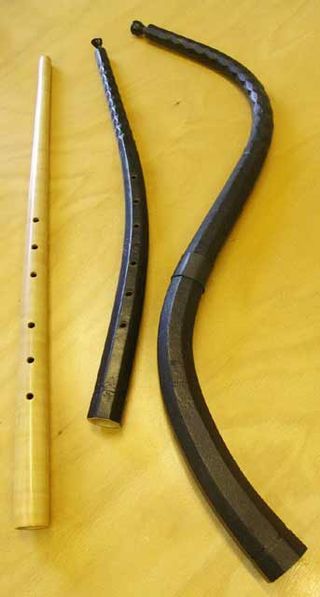
The cornett, cornetto, or zink is a wind instrument that dates from the Medieval, Renaissance and Baroque periods, popular from 1500 to 1650.

Girolamo Alessandro Frescobaldi was an Italian composer and virtuoso keyboard player. Born in the Duchy of Ferrara, he was one of the most important composers of keyboard music in the late Renaissance and early Baroque periods. A child prodigy, Frescobaldi studied under Luzzasco Luzzaschi in Ferrara, but was influenced by many composers, including Ascanio Mayone, Giovanni Maria Trabaci, and Claudio Merulo. Girolamo Frescobaldi was appointed organist of St. Peter's Basilica, a focal point of power for the Cappella Giulia, from 21 July 1608 until 1628 and again from 1634 until his death.
Hendrik "Henk" Bouman is a Dutch harpsichordist, fortepianist, conductor and composer of music written in the baroque and classical idioms of the 17th and 18th century.

Johann Joseph Fux was an Austrian composer, music theorist and pedagogue of the late Baroque era. His most enduring work is not a musical composition but his treatise on counterpoint, Gradus ad Parnassum, which has become the single most influential book on the Palestrinian style of Renaissance polyphony.
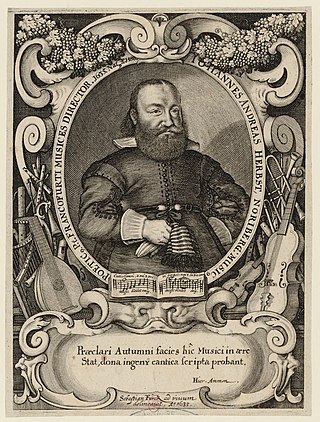
Johann Andreas Herbst was a German composer and music theorist of the early Baroque era. He was a contemporary of Michael Praetorius and Heinrich Schütz, and like them, assisted in importing the grand Venetian style and the other features of the early Baroque into Protestant Germany.
Willi Apel was a German-American musicologist and noted author of a number of books devoted to music. Among his most important publications are the 1944 edition of The Harvard Dictionary of Music and French Secular Music of the Late Fourteenth Century.
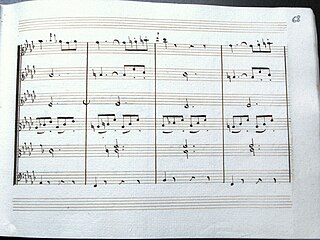
GaetanoBrunetti was an Italian-born composer who was active in Spain during the reigns of kings Charles III and Charles IV. As well as being musically influential at court, Brunetti was a key contributor to the modernization of Spanish musical culture in the late 18th century.
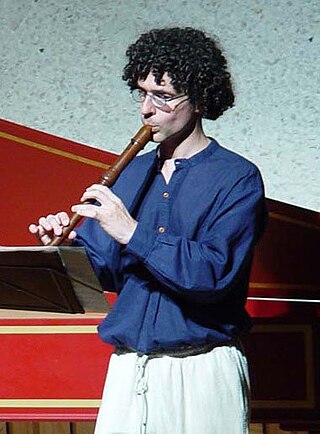
Carlos Serrano is a recorder and early woodwinds player. He completed high school studies at Colegio San Carlos in Bogotá. After studying recorder at Oberlin Conservatory in Ohio and Mannes College of Music in New York with Philip Levin, and with Pedro Memelsdorff in Italy, he graduated from the Early Music Institute at Indiana University as pupil of Eva Legene and Michael McCraw. In 1988 he founded the early music ensemble Musica Ficta (Colombia), with which he has specialized in the performance of Latin-American and Spanish renaissance and baroque music. With this ensemble he has performed in Europe, the Americas, the Far and Middle East. He has recorded for the labels Jade (France), Arion (France), Centaur (USA), Arts Music (Germany), Etcetera (Belgium) and Lindoro (Spain). He taught music at Pontificia Universidad Javeriana in Bogotá.
Andreas Staier is a German pianist and harpsichordist.
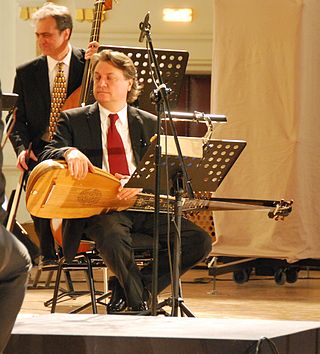
Luca Pianca is a Swiss musician-lutenist whose specialty is archlute. In 1985 he co - founded Il Giardino Armonico., a pioneering Italian early-music ensemble based in Milan. He has premiered works by the contemporary lutenist-composer Roman Turovsky-Savchuk at international festivals, and received numerous international awards for his recordings.

Vittorio Ghielmi is an Italian musician, conductor, composer. Compared by critics to Jasha Heifetz ("Diapason") for his virtuosity, and described as "An Alchemist of sound" for the intensity and versatility of his musical interpretations, Vittorio Ghielmi attracted notice while still very young for his new approach to the viola da gamba and to the sound of early music repertoire. His multifaceted training has made him an appreciated and creative musician as well as a sought-after conductor and coach for modern orchestras or orchestras with original instruments. He is Professor for viola da gamba and Head of the Department für Alte Musik at the Mozarteum Universität Salzburg and visiting professor at the Royal College of London. He is graduate at the Università Cattolica di Milano. He was born in Milan, Italy, where as a child he began his study of music with the violin, the double bass and later the viola da gamba and composition. In 1995 he was the winner of the "Concorso Internazionale Romano Romanini per strumenti ad arco" (Brescia). His fieldwork within old musical traditions surviving in forgotten parts of the world and bringing new perspectives to the interpretation of European "early music" led to him being presented the "Erwin Bodky Award" . He studied the viol with Roberto Gini, Wieland Kuijken and Christophe Coin (Paris). Associations with instrument maker, engineer and humanist Luc Breton (CH) as well as with many musicians of non-European traditions have been fundamental to his musical career, creating a deeper reflexion on the nature of sound used in early and modern European tradition . As viola da gamba soloist or conductor, he has appeared with many of the world's most famous orchestras in the fields of both classical and ancient music. He performs since youth recitals in duos with his brother Lorenzo Ghielmi and with the lutenist Luca Pianca, in the most important halls. As soloist or chamber musician, he has shared the stage with artists such as Gustav Leonhardt (duo), Cecilia Bartoli, Andràs Schiff, Thomas Quasthoff, Mario Brunello, Viktoria Mullova, Giuliano Carmignola, Christophe Coin, Reinhard Goebel, Giovanni Antonini, Ottavio Dantone, Enrico Bronzi etc. He is one of the few viola da gamba players regularly invited to appear as a soloist-conductor with orchestra. He has been invited to play in the world première of many new compositions, many of which have been dedicated to him . From 2007 to 2011 he was assistant to Riccardo Muti at the Salzburg festival. In 2007 he conceived with the Argentinian singer Graciela Gibelli and conducted a show, based on Buxtehude's "Membra Jesu Nostri", with the American film maker Marc Reshovsky (Hollywood) and the Swedish choir "Rilke Ensemble" (G.Eriksson); the project was produced by the Semana de musica religiosa de Cuenca (Madrid) and brought later to the Musikfest Stuttgart in 2010. Over three nights in 2009, he gave a performance of Forqueray's complete works for viola da gamba at De Bijloke, Ghent (B). He has been artist in residence at Musikfest Stuttgart 2010, the Segovia festival 2011, and the Bozar Bruxelles 2011. In 2012 he conducted Handel's Water music at the Portogruaro Festival (Venice) with a spectacle on the river Lemene conceived by Monique Arnaud. In 2018 he conducted the Opera Pygmalion by Rameau at the Drottningholms Slottsteater (Stockholm), with the régie of Saburo Teshigawara.; the new conception of this spectacle was so described in the Financial Times : "In their new production for Drottningholm Slottsteater, the Japanese dancer and choreographer Saburo Teshigawaraand Italian conductor and viola da gamba player Vittorio Ghielmi create a genuine masterpiece which combines exquisite music-making with experimental dance and modern lighting effects with the theatre’s unique 18th-century stage technology. Indeed, it is some time since the theatre has been so marvellously and innovatively put to use.“
Don LeRoy Smithers is an American music historian and performer on natural trumpet and cornetto. He is a pioneer for the revival of the authentic, uncompromised natural trumpet.

Peter Watchorn is an Australian-born harpsichordist who has combined a virtuosic keyboard technique, musical scholarship and practical experience in the construction of harpsichords copied from original instruments of the 17th and 18th centuries. As well as presenting many solo public performances and broadcasts of baroque keyboard music and participating in choral and orchestral performances, he has made numerous commercial CD recordings of solo harpsichord music from the 17th and 18th centuries.

John Griffiths is a musician and musicologist specialised in music for guitar and early plucked instruments, especially the vihuela and lute. He has researched aspects of the sixteenth-century Spanish vihuela, its history and its music. He has also had an international career as a solo lutenist, vihuelist, and guitarist, and as a member of the pioneer Australian early music group La Romanesca. After a thirty-year career at the University of Melbourne (1980–2011), he now works as a freelance scholar and performer.
Pascal Dubreuil is a French harpsichordist, a teacher and a specialist of musical rhetoric.
David Erler is a German countertenor, a male classical singer in the alto vocal range, specialising in Baroque music in historically informed performance. He is also a music editor for Breitkopf & Härtel.
Anthony Maydwell is an Australian harpist, educator, musicologist and director of the Summa Musica Chamber Choir and Ensemble.

William Dongois is a French brass player with a focus on the cornett.
Musica Fiorita was an ensemble for baroque music founded in 1990 and based in Basel, which was conducted by the harpsichordist Daniela Dolci. The ensemble concentrated in particular on rediscovering unknown works by composers of the 17th and 18th centuries and their historical performance practice. In March 2020, it ceased its concert activities.
Riccardo Minasi is an Italian violinist and conductor in the field of historically informed performance.
References
- 1 2 (Deutsch) Cosimo Stawiarski, Violine (in German) escapades.de
- ↑ "Les Cornets Noirs"
- 1 2 Musica Poetica